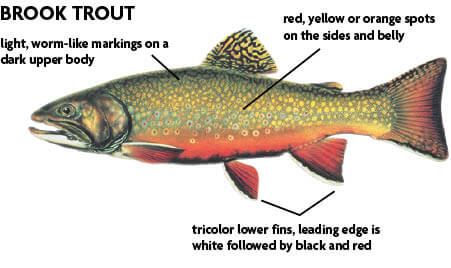Brook Trout
The brook trout (Salvelinus fontinalis) is a species of freshwater fish in the char genus Salvelinus of the salmon family Salmonidae. It is native to Eastern North America in the United States and Canada, but has been introduced elsewhere in North America, as well as to Iceland, Europe, and Asia. In parts of its range, it is also known as the eastern brook trout, speckled trout, brook charr, squaretail, or mud trout, among others.[3] A potamodromous population in Lake Superior, as well as an anadromous population in Maine, is known as coaster trout or, simply, as coasters. The brook trout is the state fish of nine U.S. states: Michigan, New Hampshire, New Jersey, New York, North Carolina, Pennsylvania, Vermont, Virginia, and West Virginia, and the Provincial Fish of Nova Scotia in Canada.
The brook trout was first scientifically described as Salmo fontinalis by the naturalist Samuel Latham Mitchill in 1814. The specific epithet "fontinalis" comes from the Latin for "of a spring or fountain", in reference to the clear, cold streams and ponds in its native habitat. The species was later moved to the char genus Salvelinus. Though commonly called a trout, the brook trout is thus actually one of the chars, which in North America also include the lake trout, bull trout, Dolly Varden, and the Arctic char.
There is little recognized systematic substructure in the brook trout, but two subspecies have been proposed. On the other hand, three ecological forms are distinguished.
The brook trout produces hybrids both with its congeners Salvelinus namaycush and Salvelinus alpinus, and intergeneric hybrids with Salmo trutta.[8][9]
The splake is an intrageneric hybrid between the brook trout and lake trout (S. namaycush). Although uncommon in nature, they are artificially propagated in substantial numbers for stocking into brook trout or lake trout habitats.[10] Although they are fertile, back-crossing in nature is behaviorally problematic and very little natural reproduction occurs. Splake grow more quickly than brook trout and become piscivorous sooner and are more tolerant of competitors than brook trout.[11]
The tiger trout is an intergeneric hybrid between the brook trout and the Eurasian brown trout (Salmo trutta). Tiger trout occur very rarely naturally, but are sometimes artificially propagated. Such crosses are almost always reproductively sterile. They are popular with many fish-stocking programs because they can grow quickly, and may help keep coarse fish (wild non "sport" fish) populations in check due to their highly piscivorous (fish-eating) nature.[12]
The sparctic char is an intrageneric hybrid between the brook trout and the Arctic char (S. alpinus)
The brook trout has a dark green to brown color, with a distinctive marbled pattern (called vermiculation) of lighter shades across the flanks and back and extending at least to the dorsal fin, and often to the tail. A distinctive sprinkling of red dots, surrounded by blue halos, occurs along the flanks. The belly and lower fins are reddish in color, the latter with white leading edges. Often, the belly, particularly of the males, becomes very red or orange when the fish are spawning.[citation needed]
Typical lengths of the brook trout vary from 25 to 65 cm (9.8 to 25.6 in), and weights from 0.3 to 3 kg (0.66 to 6.61 lb). The maximum recorded length is 86 cm (34 in) and maximum weight 6.6 kg (15 lb). Brook trout can reach at least seven years of age, with reports of 15-year-old specimens observed in California habitats to which the species has been introduced. Growth rates are dependent on season, age, water and ambient air temperatures, and flow rates. In general, flow rates affect the rate of change in the relationship between temperature and growth rate. For example, in spring, growth increased with temperature at a faster rate with high flow rates than with low flow rates.
Brook trout are native to a wide area of Eastern North America, but are increasingly confined to higher elevations southward in the Appalachian Mountains to northern Georgia and northwest South Carolina, Canada from the Hudson Bay basin east, the Great Lakes–Saint Lawrence system, the Canadian maritime provinces, and the upper Mississippi River drainage as far west as eastern Iowa.[7] Their southern historic native range has been drastically reduced, with fish being restricted to higher-elevation, remote streams due to habitat loss and introductions of brown and rainbow trout. As early as 1850, the brook trout's range started to extend west from its native range through introductions. The brook trout was eventually introduced into suitable habitats throughout the western U.S. during the late 19th and early 20th centuries at the behest of the American Acclimatization Society and by private, state, and federal fisheries authorities.[16] Acclimatization movements in Europe, South America, and Oceania resulted in brook trout introductions throughout Europe,[13] in Argentina,[17] and New Zealand.[18] Although not all introductions were successful, a great many established wild, self-sustaining populations of brook trout in non-native waters.
The brook trout inhabits large and small lakes, rivers, streams, creeks, and spring ponds. They prefer clear waters of high purity and a narrow pH range and are sensitive to poor oxygenation, pollution, and changes in pH caused by environmental effects such as acid rain. The typical pH range of brook trout waters is 5.0 to 7.5, with pH extremes of 3.5 to 9.8 possible.[19] Water temperatures typically range from 34 to 72 °F (1 to 22 °C). Warm summer temperatures and low flow rates are stressful on brook trout populations—especially larger fish

